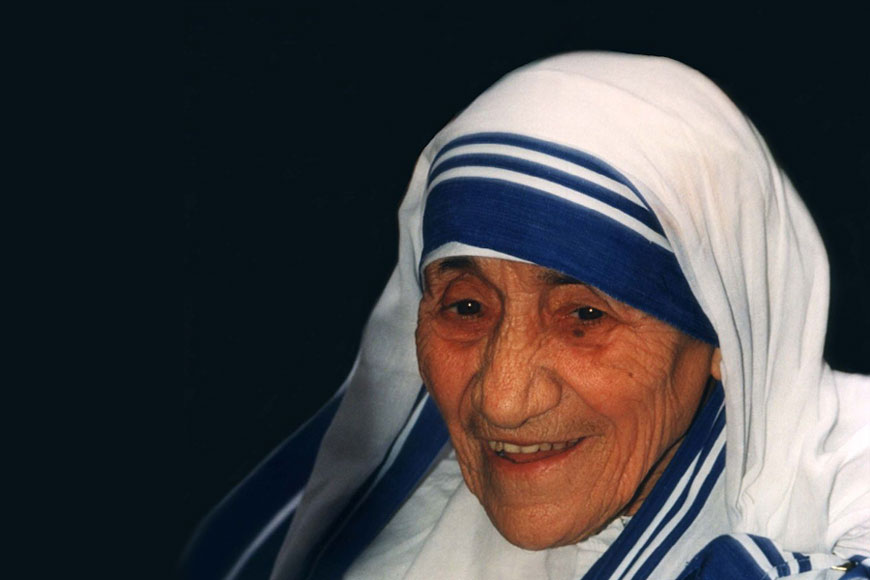If you can’t feed a hundred people, then feed just one. A tribute to Mother Teresa

‘Our Lord wants me to be a free nun covered with the poverty of the cross. Today, I learned a good lesson. The poverty of the poor must be so hard for them. While looking for a home I walked and walked till my arms and legs ached. I thought how much they must ache in body and soul, looking for a home, food and health. Then, the comfort of Loreto [her former congregation] came to tempt me. You have only to say the word and all that will be yours again, the Tempter kept on saying. ... Of free choice, my God, and out of love for you, I desire to remain and do whatever be your Holy will in my regard. I did not let a single tear come…’
The ever-iconic smiling wrinkled face of Mother Teresa and her words in her diary reflect how dedicated she was to the city of Kolkata. Yet she writes the temptation to return to the life of comfort at times. But she never did so, rather she dedicated her entire life to the cause of the poor, needy, old and abandoned on the streets of Kolkata, from children to lepers, from frail diseased patients to the dying. It was in the year 1946, Teresa experienced what she later described as ‘the call within the call’ when she travelled by train to the Loreto convent in Darjeeling from Calcutta for her annual retreat. ‘I was to leave the convent and help the poor while living among them. It was an order. To fail would have been to break the faith.’ Though no one knew it at the time, Sister Teresa had just become Mother Teresa.
Mother began her missionary work with the poor in 1948, replacing her traditional Loreto habit (the attire they wore) with a simple, white cotton sari with a blue border. Teresa adopted Indian citizenship, spent several months in Patna to receive basic medical training at Holy Family Hospital and ventured into the slums. She founded a school in Motijhil, Kolkata, before she began tending to the poor and hungry. At the beginning of 1949, Teresa was joined in her effort by a group of young women, and she laid the foundation of Missionaries of Charity.
Also read : The Prophet of Indian Nationalism
Her efforts quickly caught the attention of the administration and as Mother Teresa wrote in her diary that her first year was fraught with difficulty. With no income, she begged for food and supplies and experienced doubt, loneliness and the temptation to return to the comfort of convent life during these early months. Yet she stood her ground. She writes: ‘By blood, I am Albanian. By citizenship, an Indian. By faith, I am a Catholic nun. As to my calling, I belong to the world. As to my heart, I belong entirely to the Heart of Jesus.’ Not just in Kolkata, at the height of the siege of Beirut in 1982, Teresa rescued 37 children trapped in a front-line hospital by brokering a temporary cease-fire between the Israel and Palestine. Accompanied by Red Cross workers, she travelled through the war zone to the hospital to evacuate the young patients.
She also travelled to assist the hungry in Ethiopia, radiation victims at Chernobyl and earthquake victims in Armenia. By 1996, Teresa operated 517 missions in over 100 countries. Her Missionaries of Charity grew from twelve to thousands, serving the ‘poorest of the poor’ in 450 centres worldwide. The first Missionaries of Charity home in the United States was established in New York City and by 1984 the congregation operated 19 establishments throughout the country. But what was unique about Mother Teresa’s connect with Kolkata and Bengal was probably more evident in her adoption of the blue lined sari, that has almost been an iconic dress. This sari was a kind of calling as Mother Teresa mentions in her diary. She mentions it was like Jesus Christ wishing her to wear a sari in the Bengali style.
Even today the sari is worn by every missionary connecting the Nobel Laureate and Saint Mother Teresa to the streets of Kolkata that had seen a frail nun often extending her helping and loving hand to those in need. Even after her death, she will forever be the Mother of Kolkata.











